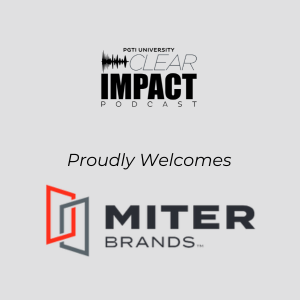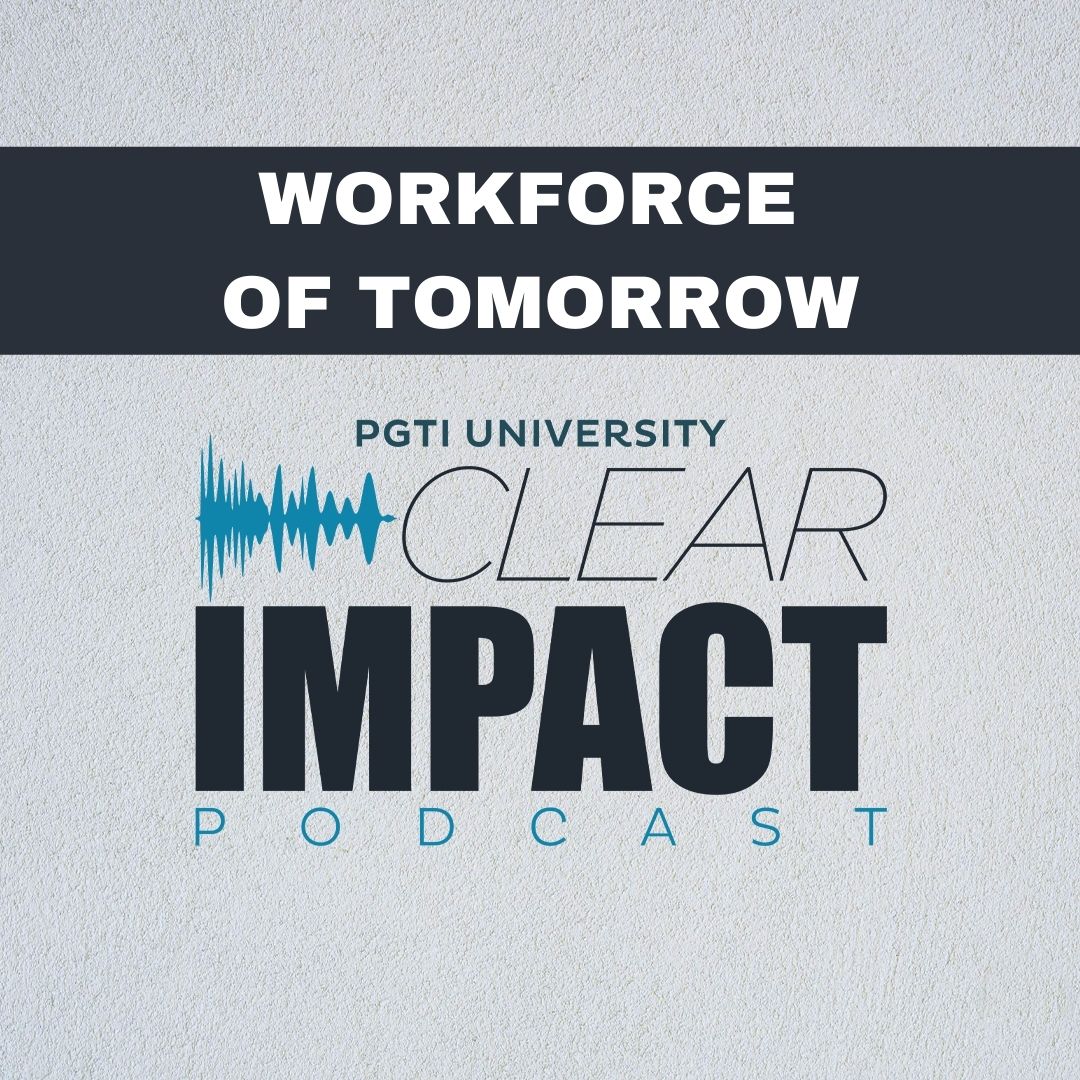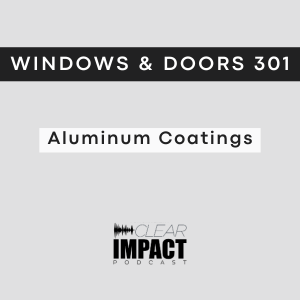Episode Transcript
Speaker 1 00:00:04 Welcome to the Clear Impact Podcast, brought to you by pg t I University. Thanks for joining us today. My name is Sherry Connor and I am your host. So good morning. We are here on the Clear Impact Podcast and today we're doing a special episode around the My Safe Florida program. And sitting in studio with us is Glen Stevens. Welcome.
Speaker 2 00:00:29 Thank you. Thank you. Glad for having me. Yeah,
Speaker 1 00:00:31 I'm glad that you could make it down and record in person. It's always a better experience, I feel like. And so your card was handed to me recently from Stephanie czi. And so tell us a little bit about your background, your experience, and your current work.
Speaker 2 00:00:46 Well, for me, I'm a native to Sarasota Manatee County area. Okay. So this is all home week for me. Right. My family was in construction, so growing up, always been in and around it one way or the other. And right around, or just before Hurricane Charlie hit, I had sat and passed my contractor's exam and all the other fun stuff. And the, uh, that license showed up that weekend. Oh,
Speaker 1 00:01:15 Fun.
Speaker 2 00:01:15 Oh yeah. So talking about jumping right into the fire and really seeing the impact of all of that. So it was really cool. I'm sad as well, obviously. Right, sure. But from there, contractor in educating, I've been teaching in some form were fashion since the mid nineties, predominantly with adults in software construction or home inspection, which is what I'm currently doing right now. I'm a state licensed home inspector. Been doing nothing but home inspections and education since 2011 and having fun. I currently sit on the State Association for home inspectors, uh, the Florida Association of Building Inspectors, also known as Favi, uh, sit on the, as a board of director there, as well as this year's secretary and co-chair of their education. So educating teaching is really my big love.
Speaker 1 00:02:10 Okay. Well then we're in the same lane. Yeah. And so we understand right now, like I've had conversations just recently, I know at least with three or four people who said that they got a letter from their insurance company that they're being canceled unless they put on a new roof or you know, pay triple the rates or whatever. And so it's getting rough out there for our homeowners and the state has responded through the My Safe Florida program. And so can you tell us a little bit about this from your perspective as an inspector?
Speaker 2 00:02:42 Sure. So the, my Safe Florida Home Program is a state funded grant program by which it is a 2 21. So for every dollar the homeowner spends the state, if they're approved for the grant, they'll receive $2 up to $10,000. So it's a great, great opportunity for a lot and a lot of homeowners to harden their homes. And my involvement with my Safe Florida Home program is actually because of my involvement with the Florida Association of Building Inspectors. We've been working very hard with other agencies within the state, and we kind of went through that whole process and everything and seeing what was happening with legislation and insurance and when this program came up, we loved the education side of things. So we really stepped in to help out. And we've been fundamental in helping educate not only the homeowners, but the contractors and the inspectors going out and doing that program. So we've been working very hard with that and just trying to make sure that everybody gets the right information and understand what this wind mitigation process is and what they could be available for via the grants. Yeah,
Speaker 1 00:04:03 We actually recorded last week with Tim O'Neill from the Department of Finance in Tallahassee, and he gave us a ton of information. So his episode will air just before this one. Awesome. And so we've got a good grip on the qualifications and some of the process. So I know that you're not obviously going to be the only inspector involved in this because there's only one of you, but what in general does that look like when you step into a house? So they've gotten a list of approved inspectors through the state, through the website, they call you, you make an appointment, you go out. What does that process look like?
Speaker 2 00:04:41 Well, actually I'm not involved in that specific element of it. Okay. So what the state has done, the state has broken up, the legislatures broke up the state in two, three regions. Okay. One, two, and three. And then they, based upon a contract bid and awarded in each region, three wcs, wind mitigation, basically they're the ones who manage the program per their inspector. So they're charged with hiring the inspector, getting the request for the inspection, setting up the schedule, and sending the inspectors out to do that. Okay. They've worked very well together to establish what needs to be done. And they've also followed a lot of what Port Association building inspectors guidelines have been put together on. So they've worked real hard in making sure that everything that's being inspected the same way. And that's very important to us because there's so many different variations of how an inspector has been trained and whether or not they're properly understanding what they're looking for. So it's, it's critical.
Speaker 1 00:05:46 That makes sense. How do they, so do they find an approved inspector through the website?
Speaker 2 00:05:52 Yeah, basically when the homeowner puts in a request, that request then gets channeled to one of the wcs and then the W C E assigns it to an inspector in the area. So it is from that point that an inspector will go out and perform a wind mitigation inspection based upon the state standard. And then the homeowner receives a report that's a lot more detailed than your average wind mitigation inspection. And that report lets them know what features they actually do have and what features they can possibly receive in grant monies. Mm-hmm. <affirmative>, so what upgrades would they be qualified for? The homeowner then takes that information, goes onto the My Safe Florida Home website and finds a contractor, contractor comes in, does the upgrade, and then an inspector comes back out to approve it from there. Now the homeowner submits for reimbursement of that grant and if that reimbursement was done in accordance to, they can get back up to $10,000.
Speaker 1 00:07:06 So what is the timeframe usually involved for a homeowner receiving an inspection? What is that?
Speaker 2 00:07:12 My understanding, once they submit their information in, it can be as quick as a couple of weeks up to 60 days. Okay. So it can be time consuming and impatient for a homeowners. Right. When they get that taken care
Speaker 1 00:07:27 Of and then it's just like an hour or so once they're there.
Speaker 2 00:07:30 Yeah. With the inspector, most wind mitigation inspections will run 45 minutes to an hour depending on,
Speaker 1 00:07:38 And so I'm assuming that's interior, exterior, or is it just all exterior?
Speaker 2 00:07:43 Well, it predominantly exterior because the wind mitigation is looking at predominantly this structure, the wind sustaining features of a home. And that is the roof, the shape of the geometry of the home, the connection of the roof decking to the trusses and the rafters, and then how those trusses and rafters are attached to the wall structures. Those are the main items. The other item, which where PPG T comes into play and window manufacturers is opening protection are the doors and windows for the home impact rated or protected with storm shutters. So in a nutshell, that is the report. Okay. And that's what they're inspecting too. So the inspector will have to get up into the attic space, may have to get into the home to look at the doors and windows and look for the labels or the etchings. So we've gotta be able to verify those openings are what they are. But the inspector will always climb up into the attic space.
Speaker 1 00:08:42 Yeah. And I know that the building codes change every three years, and so if your home is, you know, 20 or 30 years old, there's been a number of revisions to that code and so they may not be in the best position. So it is a good idea for them to have somebody come out and take a look and see if they can get reimbursed for it. Most
Speaker 2 00:09:02 Definitely. And that's a look great program and the legislature's going through right now to add additional funding to that and expand the program. So to further in the state that's still going through the different committees and everything for that. And FAVI is, is listening to those conversations as well. So.
Speaker 1 00:09:19 Awesome. Well, I really appreciate your sharing a little bit of the knowledge that is gonna help people find out about this and know what to expect when they do log in and get started with this process. And is there anything else?
Speaker 2 00:09:34 That's pretty much what the program is. It's pretty cool.
Speaker 1 00:09:36 Okay. Well, Glenn, I really appreciate your time today. Thank you. Thank you. All right. Have a good day. You
Speaker 2 00:09:41 Too.
Speaker 1 00:09:42 PG t i University is the customer education team for an entire family of brands. We began with the original Easy Breeze, porch and closure line, then became P G T, America's leading brand of impact resistant windows and doors. We then added cgi, CGI I C Window, Western Windows Systems, new South Windows, echo, windows, and doors and land, windows and doors, and our latest acquisition, Martin Garage doors. We create products built to withstand major storms, keeping people safe, secure, and prepared. Our exceptional brands give you the protection you need without compromising design or functionality. PPG t I University is here to educate you, our listener, so that you can be a more informed consumer of window and door products.


